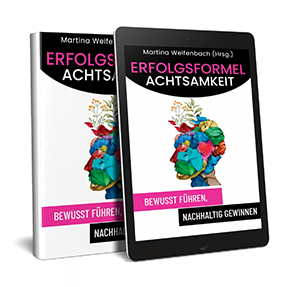Mindfulness as an opportunity for innovation
Innovation is an invitation to imagine something new and to create reality from this imagination. How can mindfulness help in the development of innovations?
The word “innovation” comes from the Latin “innovare” and means to renew. Innovation research distinguishes between radical and incremental innovation. Radical refers to new products, services, offers or business models. Incremental describes an innovation that arises from something that already exists.
Companies take various approaches to promote innovation. They support internal research and development units, innovation departments or internal entrepreneurs, who dedicate themselves to innovative projects. They provide innovation budgets or organise hackathons in which ideas are turned into prototypes in a short space of time. Other options include collaboration with research institutes at colleges and universities, spin-offs, the purchase of innovations or collaboration with start-ups.
Despite these various approaches, many innovations fail to achieve their goals; in particular the innovation of business models, which is considered the supreme discipline of innovation, is often a challenge in corporate reality.
Challenges in the innovation of business models
Companies that have pursued a successful business model for a long time often establish a kind of norm to which everyone in the company has become accustomed. Routines, processes, procedures and strategies are geared towards this business model. It has become ingrained in the minds and actions of managers and employees and conveys a sense of security.
However, this sense of security is deceptive, as advancing digitalisation often shows that successful business models need to evolve or innovate. What worked yesterday will often no longer work tomorrow. However, in addition to the deceptive feeling of security, there is another challenge that is easily overlooked: cognitive bias.
Cognitive bias describes the human need for confirmation of what is known and supposedly safe. In the context of innovating a business model, people look for familiar rules in the innovation process that correspond to the old model and therefore confirm their previous assumptions and decisions. However, there is a risk that new ideas and innovations will be ignored or rejected from the outset because they feel uncertain, unknown and therefore irrelevant.
How can mindfulness promote innovation?
This is where mindfulness comes into play. If innovation is the invitation to imagine something new and to create reality from this imagination, then mindfulness is the invitation to be present. It is the opportunity to consciously perceive the here and now with all your senses.
The conscious perception of the present moment can help people in companies to recognise
- where new opportunities arise in the market,
- what no longer works and – most importantly
- where the fear of change comes from and what worries accompany new ideas or innovations.
And how can we perceive the present moment? With mindfulness practices such as yoga, meditation, conscious breathing or mindful walking. This may sound a little unusual, but neuroscience has shown that conscious breathing, for example, helps to increase calmness and serenity and boost inner resilience. By actively calming the nervous system, practitioners are less stressed and thus create space for active decision-making. Stress triggers adrenaline and noradrenaline – hormones that ensure the ability to act quickly, but also trigger the so-called fight-or-flight mode, in which the focus narrows and one concentrates on the quickest possible solution to the current problem. The lower the stress level, the broader the perception and the more room there is in the mind to consider different ideas and solutions.
For innovation in the company, this can mean that those responsible for innovation realise whether they are still actively shaping the process or whether they are hindering innovation out of fear and uncertainty.
How do mindfulness practices help with empathy, resilience or creativity?
Mindfulness practices such as meditation increase compassion and empathy. Here too, neuroscience today shows how different areas of the brain are activated by appropriate exercises.
Innovation requires the design of new products, services and business models with a view to changing customer needs. Customers today have an increased demand for simplified usability of products and sustainability. Mindfulness practices of empathy help to keep the user in mind and design innovation for them. This not only results in improved customer orientation, but also more agility in relation to constantly changing customer behaviour.
Mindfulness practices such as open meditation – a meditation exercise that focuses on attentive perception – increase awareness, openness and curiosity. The origins of this form of exercise are attributed to Zen Buddhism and are often referred to as the supreme discipline of mindfulness practice, as many people find it difficult not to lose themselves in wandering thoughts. Please note: we all think and our neural networks are actually “firing” all the time. Meditation and mindfulness often help us to realise that we are thinking and that some thoughts are simply not allowed to think. The practice of open meditation therefore helps us to recognise thoughts and look at them. It also helps us to distance ourselves from existing beliefs and cognitive bias and create space for new ideas. This gives rise to creativity, which is essential for innovation processes.
Ultimately, regular mindfulness practice increases self-awareness and self-image. The longer people practise mindfulness, the more they get to know themselves. Mindfulness practitioners also experience a deeper understanding of meaning and values and find it easier to incorporate these into their everyday professional and working life, for example in the design of innovation. With a view to current challenges and crises, innovation for the future can emerge that has a foundation in the clear values and goals of those driving innovation. At the same time, mindfulness in the company can help everyone in the workforce to embrace change and new situations.
Recommendations for innovation creators
If you want to get involved in incorporating mindfulness into innovation processes in a targeted manner, I would like to recommend the following five-step procedure:
Step 1: Focus on the individual innovation creator
In this process step, it is advisable to use mindfulness practices of focussed attention, such as breathing exercises. The aim of this step is to get to know mindfulness, increase self-awareness and recognise when resistance arises.
Step 2: Focus on the innovation team
In this step of the process, a combination of empathy mindfulness exercises helps to support communication and co-creation within the team. This strengthens the team dynamic.
Step 3: Focus on the members of the innovation team
In this step of the process, a combination of mindfulness exercises helps to clarify personal insights, individual values and understandings of meaning. The team can then work together to clarify the shared values and common purpose on which the innovation team is based.
Step 4: Focus on team creativity
In this process step, open meditation exercises help to initiate idea generation processes and stimulate creativity.
Step 5: Focus on the greater goal of innovation
Joint visualisation exercises help to harmonise goals and visions in the innovation team, find a common motivation and direction and bring the idea to fruition.
Final thoughts
For me, mindfulness and innovation go hand in hand. Mindfulness and mindfulness practices help to increase innovation output, drive radical innovation and secure successful innovation for the future. Mindfulness practices also help to bring the entire workforce along on the innovation journey, overcoming internal resistance that is often rooted in culture, strategies and processes.
Mindfulness is an opportunity for innovation and an invitation to make new thinking a reality. Are you ready?
Notes:
If you have any questions or thoughts about Dr Martina Weifenbach’s presentation, if you want to put the recommendations for innovation designers into practice but don’t yet know how, then simply get in touch with Ms Weifenbach. And if you want to hear more from her first, there’s something for your ears in the myndway podcast.
“Erfolgsformel Achtsamkeit. Gewusst führen, nachhaltig gewinnen” is the title of Dr Martina Weifenbach’s latest book. It contains scientifically sound and practice-orientated articles on mindfulness in business, mindfulness and creativity and mindfulness as a path to sustainability.
If you like the article or would like to discuss it, please feel free to share it in your network.

Dr Martina Weifenbach
Dr Martina Weifenbach is a pioneer in the connection between mindfulness, sustainable innovation and good work. She is the author of “Achtsamkeit und Innovation in integrierten Organisationen” and “Erfolgsformel Achtsamkeit”, and works as an executive coach and managing director of myndway. myndway is a company that offers training and consulting in the areas of mindful leadership, mental health and sustainable innovation.
Dr Martina Weifenbach has already conducted over 1,000 mindfulness training sessions for international corporations and medium-sized companies from various industries and has worked for companies such as Deutsche Telekom, Google and Mercedes Benz as well as for Berlin start-ups in the areas of innovation, strategy and human resources. During her doctorate at the University of St. Gallen, at HIIG in Berlin and at UC Berkeley, she developed a cognition model for the design of change processes.
As a keynote speaker, lecturer and consultant, Dr Weifenbach shares her vision of human and successful companies with the world. Born in the Allgäu, she came to Berlin and stayed. She loves mountain tours, her family and ice swimming, which she passes on as a Wim Hof instructor.
